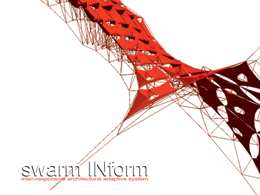STUDENTS PROJECTS
PROJECTS 2011
Student: Tasos Ioannou
Supervisors: Marios Phocas , Odysseas Kontovourkis
Department of Architecture , University of Cyprus
Date : May 2011
If we consider architecture as an object that is represented in space, the architects are largely concerned with geometry and a field of mathematics. Through the history there have been different architectural styles that seemed to represent (the logic of) each period in an attempt to resolve an issue. Our era can be characterized as the information age which may be also considered as a tool for an architect. The buildings that act as a fundamental basis to the information can be described as "smart buildings" or "kinetic architecture", and are commonly referred to as "interactive" and "responsive" environments.

This thesis deals with how the concepts of "interactive" and "responsive" environments can comply with a system that will be able to adapt and respond to various changes and a need of space, through the processes of "morphogenesis". In this process the role of the material is vital. A resent research based on existing theories and experiments has shown that the membrane is an interesting material which can easily adapt to various changes transferring also information while provoking interaction between its support system.
The membrane and its properties, as a main ingredient to carry tensile loads, can expand the potential form of the element by changing the mounting point of the formulation and rotation. Therefore the structural element is then divided into small units creating a dual system of membranes and SWRs connected by a rod. In effect, this can control the mounting of four small units that are connected to it, resulting to an increase or decrease of intensity of each unit during the moving process, depending on each position in the overall system. In the initial stages, the possible forms this tensile structure can take are checked, whilst with the aid of the "productive algorithms" the various changes resulting to the overall system are controlled by varying the tension accordingly (locally). The purpose of this system is to achieve the most even distribution of tension to all points of construction for an optimum static performance of manufacturing in the various changes in loads.





















